MIDNIGHT JOYRIDE
A musical journey through a fiery weekend of protests (and parties) in Washington DC

A DJ plays at a protest dance party in Washington DC (All photos by moi)
It’s Saturday night in Washington DC, and I’m flopped in a hotel bed with a crew of art kids toting Gucci bags and black latex masks, plagued with that particular flavor of pandemic ennui that arises from the ashes of dead nightlife. We’d just left an art opening at Von Amon Co gallery, where the works on view included abject clown dolls named Karen, and racks of Funyuns onion rings stolen from a dollar store. (I was told that shoplifting was integral to the artist Alex Bag’s praxis; this felt very apropos.) My fantasy of visiting the White House on acid had also been aborted after realizing that Trump literally built a wall around it, erecting an anti-protestor fence around the perimeter that’s made it nearly impossible to view. (Couldn’t find acid anyway, so whatever.)
“If ya’ll wanna go out, protests are the new parties,” I said drolly. “We can go to Black Lives Matter Plaza, that’s where everyone’s been hanging out.” BLM Plaza is a two-block zone opposite the White House, where BLACK LIVES MATTER was painted on the asphalt in giant yellow letters. Thousands of people were in DC that weekend for a massive rally called the 2020 March on Washington—held on the anniversary of the historic 1963 march where MLK gave his “I Have a Dream” speech. When I arrived on the eve of the march on Thursday night, I discovered BLM Plaza was the de-facto hotspot for nightly protests and dance parties—with the lines between the two often blurred.
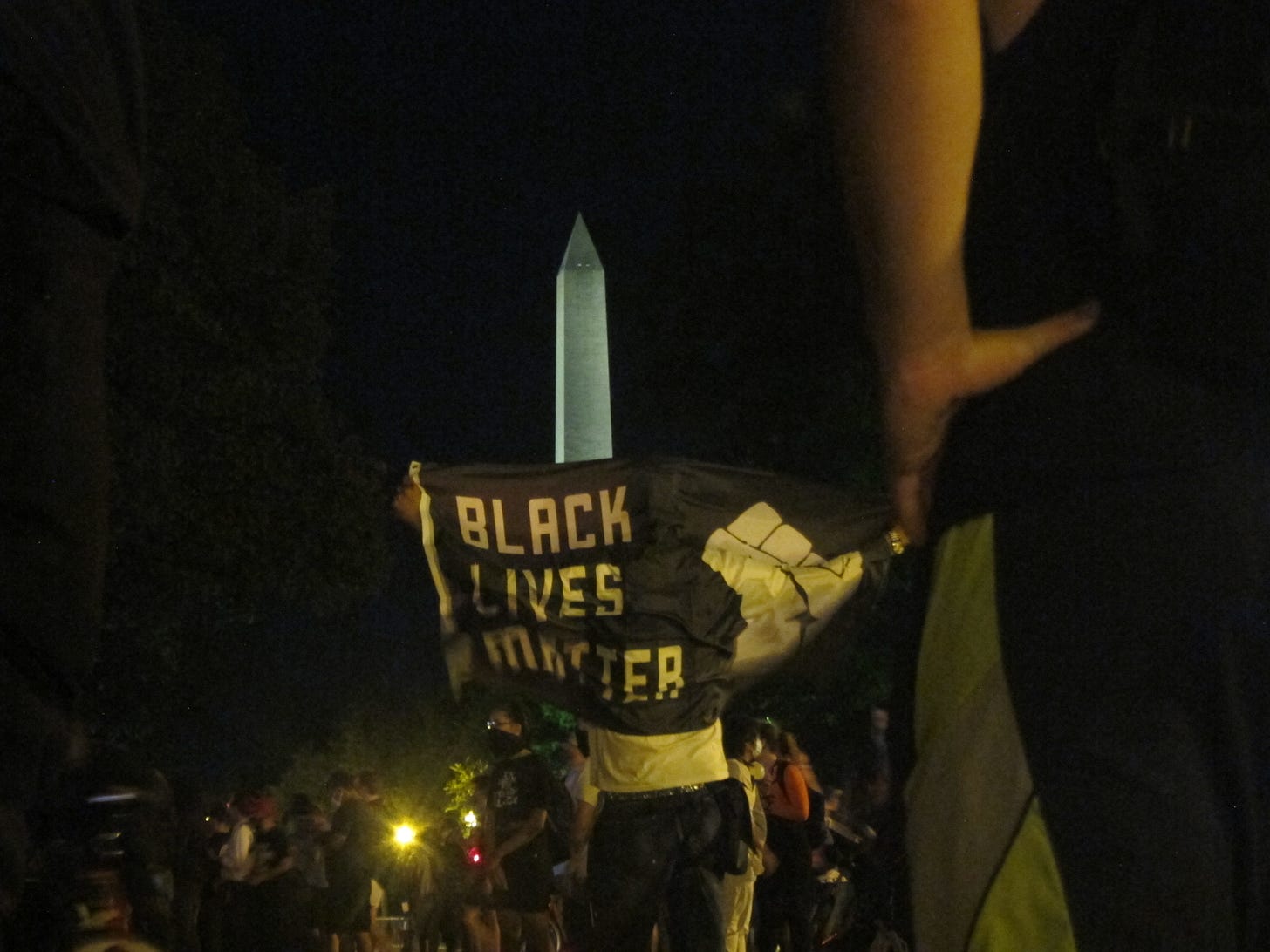
“I need to change so the police don’t think I’m antifa,” announced an LA art curator in skinny black jeans and billowing black tank top. He had to shut down his gallery in Hollywood recently because of the pandemic. The girls laughed. He kept his shirt on. I sighed and turned to Twitter. According to the livestreams, the streets of DC were burning after nights of escalating conflict, with reports of protestors lighting trash can fires and clashing violently with police.


The heat had started building on Thursday, when I pulled up to BLM Plaza and found a DJ with a laptop and a mixer parked between two traffic lights, playing for a crowd of several hundred. Trump’s anti-protestor fence was covered in protest signs, and the vibe felt like a turbo-charged block party——except instead of dance-offs, people were standing in circles chanting “Black Lives Matter” and taking turns to deliver impromptu speeches on racial justice. Many recent raves have unsuccessfully tried to bill themselves as “protest parties,” but have fallen too far on the side of mindless hedonism over political resistance to claim that label seriously. This, however, was the first real protest-party I’ve witnessed all summer.
I squeezed to the front and moshed to System of a Down’s “Chop Suey” before fireworks started popping off above our heads. The Republican National Convention had just concluded on the White House’s South Lawn, and these bombastic pyrotechnics were the finale to Trump’s acceptance speech, where he’d painted protestors as “anarchists, agitators, rioters, looters, and flag burners.” “Fuck the fireworks! We need to get him out of office,” someone screamed into a bullhorn, and the protest-party stopped dancing and started marching to the White House, angrily chanting the lyrics to YG’s “Fuck Donald Trump.”
The energy that first night was already volatile—it was like the most die-hard activists from across America were finally in the same place, and I recognized familiar faces from autonomous zones in Seattle and New York. Protestors swarmed the Republican politicians leaving the White House, jumping on their shuttle buses and following them back to their hotels. (Watching the politicians basking in the camera lights, I think they loved the attention.)

A Republican politician is confronted by protestors outside his hotel after leaving the RNC
Police tried to form human shields to protect Trump’s guests, but they were vastly outnumbered, and repeatedly pushed back into defensive circles as protestors lunged and screamed at them about being on the wrong side of history. Some cops closed their eyes, some smiled awkwardly, others even seemed to tear up a little. I wondered if they had been ordered to stand down because Trump didn’t want bad media optics of protestors getting gassed during the convention.
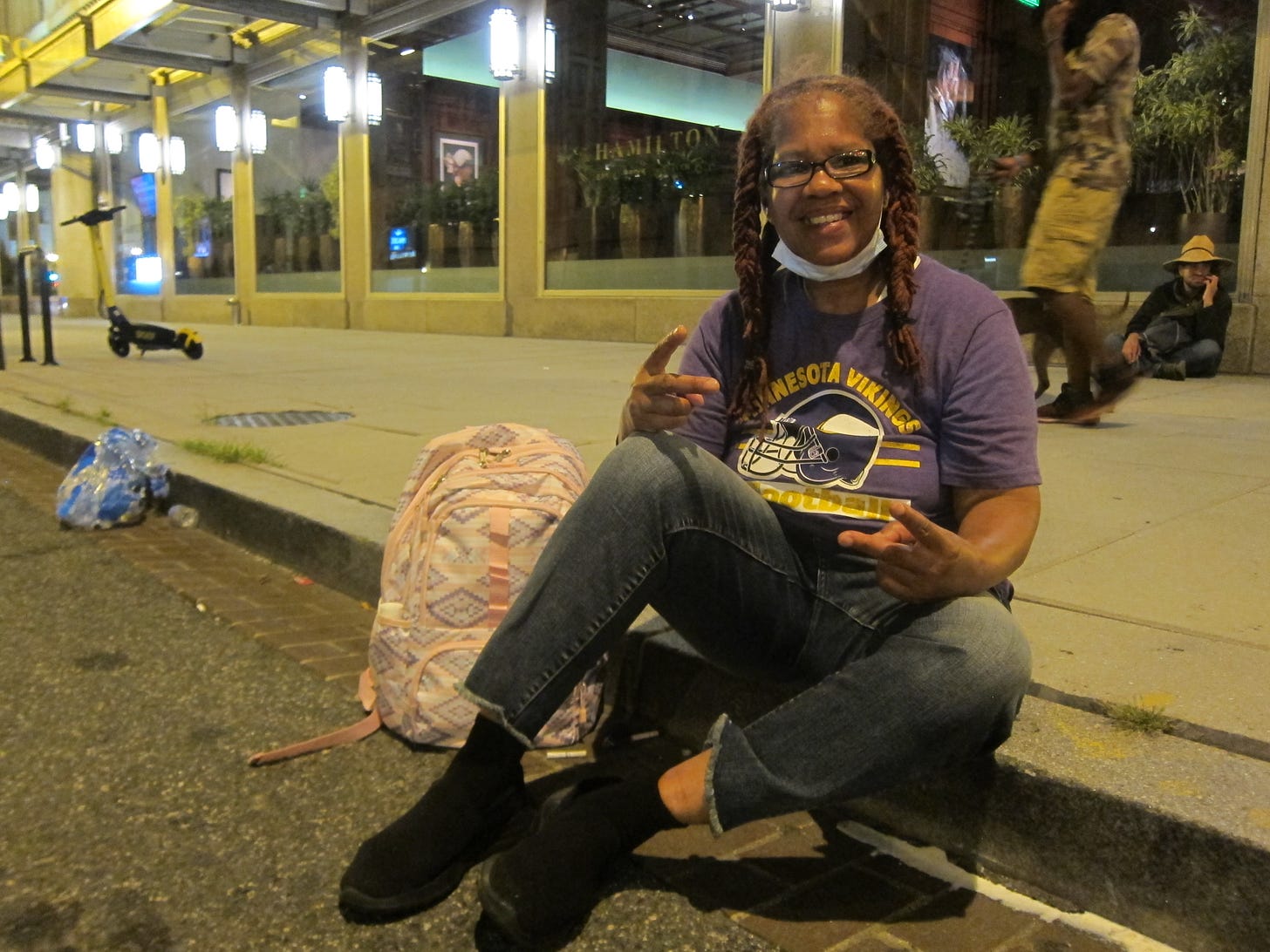
Lara, a protestor who participated in the Civil Rights movement in the 60s
“Well, this is something different…” remarked an older Black woman named Lara with hippie-pigtails, smoking a blunt on the sidelines. She told me she’d participated in the Civil Rights movement in the 60s, and what was unfolding in front of us felt like deja vu.
“How do you fight a system where, when you fight back, you get brutalized?” she said, plopping next to me on the sidewalk as we watched ambulances wail by. I asked if anything felt different about this new wave of revolt.
“Back then, the police used force too,” she replied. “They threw rocks at Dr. King’s head, they beat people with billy sticks, sicced the dogs on them—it was just ugly. But Dr. King remained nonviolent. They just kept on marching and singing.”
She gazed at the protestors admonishing police while holding their phones up to livestream the theatrics.
“White people shouting at cops? Now, that’s new,” she said gravely.
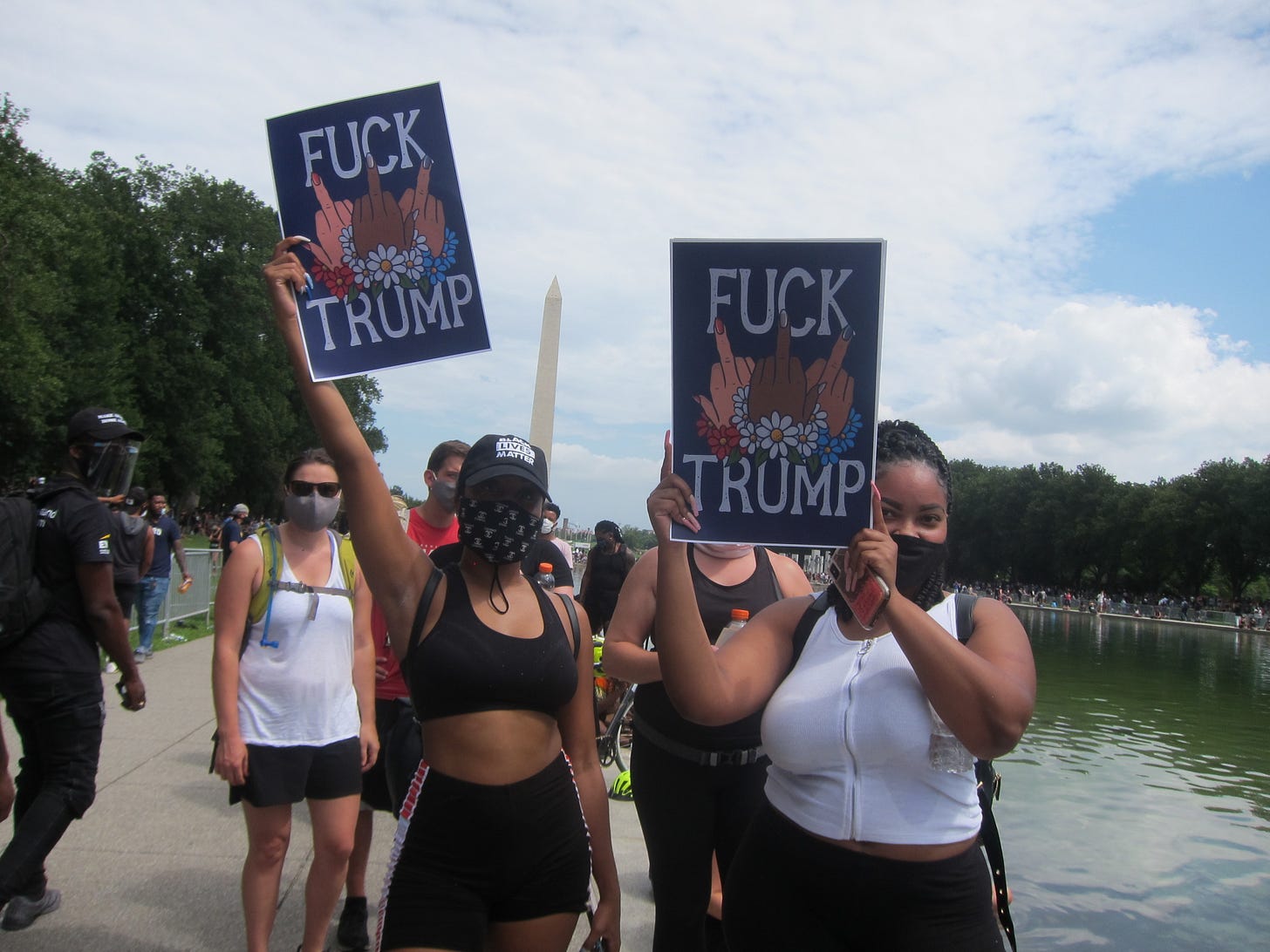
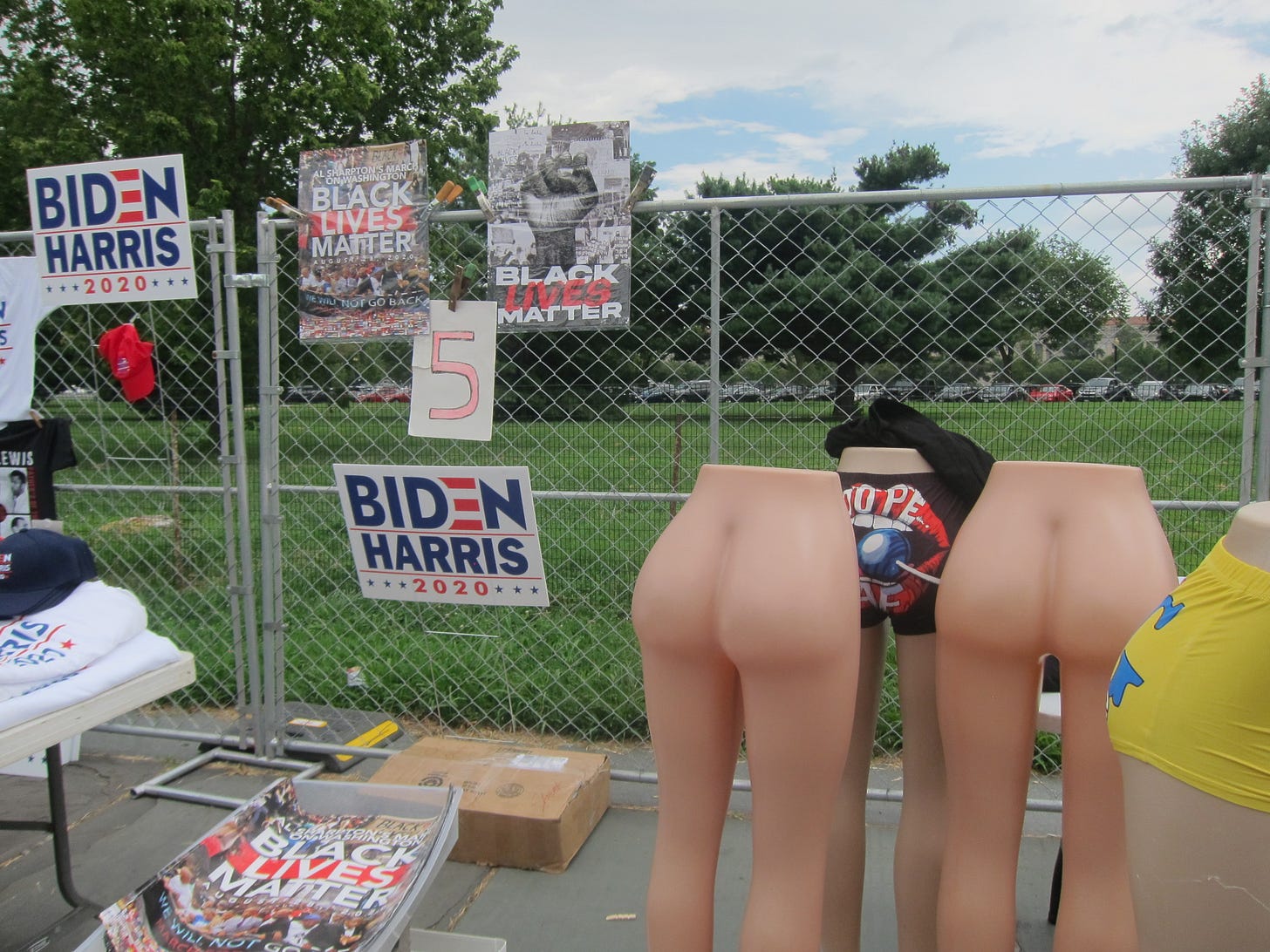
Protestors and merch at the 2020 March on Washington
On Friday, the second night of protests, thunderstorms and flash floods kept everyone except the extremists indoors. The 2020 March on Washington earlier that day had gotten mixed reviews; protestors from states with virus outbreaks were banned last-minute from coming, which dampened the turn-out Rev. Al Sharpton, who organized the march, also told the media that attendees would get their temperature checked and be sectioned into zones to allow for social distancing—but aside from the distribution of free masks, I didn’t see any of those pandemic precautions.

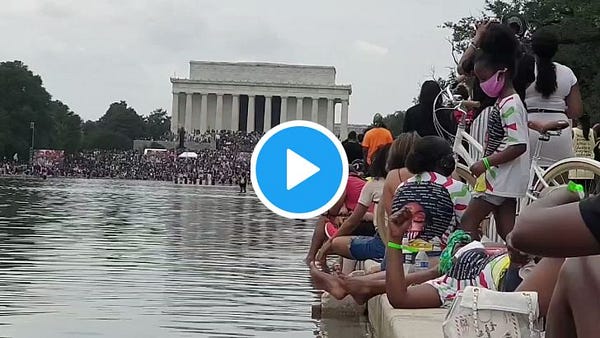
Still, family members of those killed by police violence gave powerful, heart-wrenching speeches: “America, catering to your delusions is no longer an option… we will no longer be the footstool to your oppression,” said Jacob Blake's sister Letetra Widman, and it sounded like a hymn.
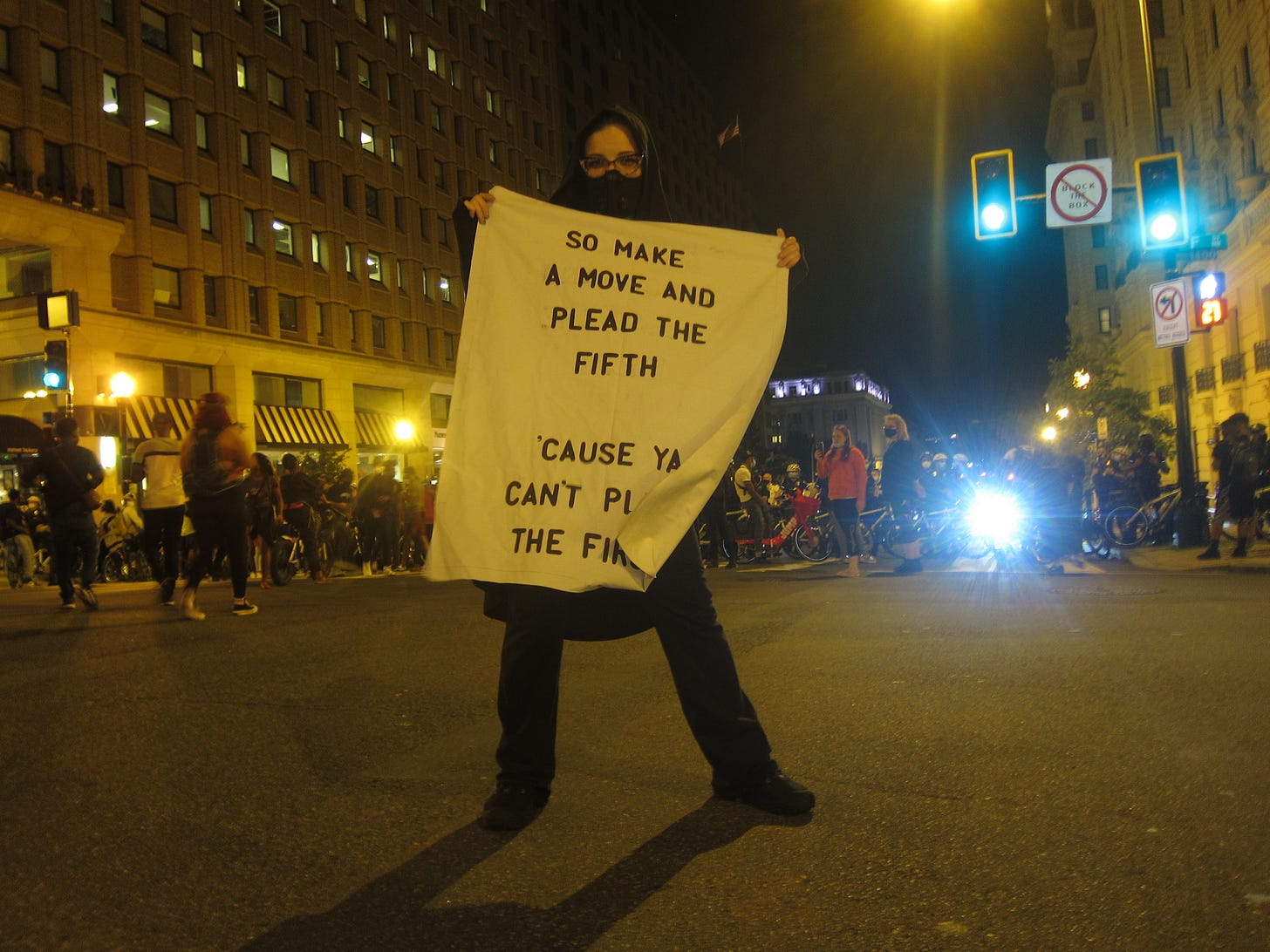
A protestor holds up a sign with Rage Against the Machine lyrics: “So make a move and plead the fifth / cause ya can’t plead the first”
So tonight it looked like all bets were off, and the protestors were out in full force. The pacifist stance police had previously adopted had evaporated, and the streets were now a war zone. My crew of art thots and I arrived at BLM Plaza just as police in riot gear were closing in, making our way past mothers and children fleeing in the opposite direction. “Looks like we got here right on time,” said the girl with the Gucci bag, as fireworks and flash bangs exploded around us. “Why the fuck do I hear drum and bass?” I said, chasing the sounds of skittering 808s to find a battalion of cops pushing protestors back on the BLACK LIVES MATTER mural.

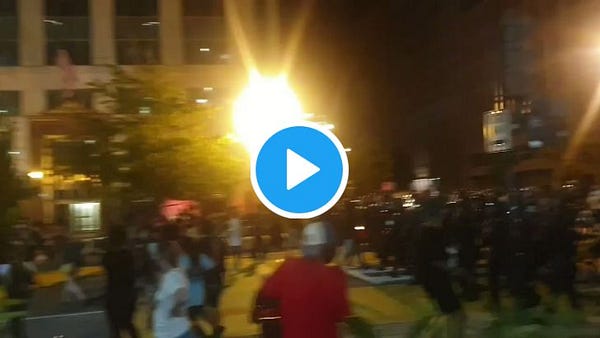
Further up the street, a caravan with speakers tethered on all sides was pumping out protest anthems to the Plaza, as protestors held up signs and danced with friends like they were at an Orwellian music festival. “ALL POWER TO THE PEOPLE, WE GONNA BE TREATED EQUAL,” bellowed one marching band fight song, drum rolls drowning out the police chanting “MOVE BACK!” while they launched canisters of pepper spray into the crowd.
Here is a BIG PROTEST PLAYLIST of protest songs put together by Ashanti Hall (AKA Blacktacular)—the music caravan DJ who hails from Portland, and is also an active member of Seattle’s drum-and-bass community. Thanks Ashanti! <3
RAVE NEW WORLD is a radical experiment in gonzo journalism fueled by our readers—subscribe to support and help take this newsletter to more protests (and parties) around the globe. You’ll also get access to our subscriber-only Discord!
Shit got real hairy when cops broke the windows of a white van with BLM spray-painted on its side that was providing cover for protestors launching water bottles at the cops. Dragging the driver out, police arrested him and continued to beat back protestors down the BLACK LIVES MATTER mural. (The driver, a street medic who has been going to protests around the country providing aid, was later released with no charges.)
Metal shrapnel from a rubber bullet hit a protestor in the leg, and he collapsed near me, screaming for help. Street medics surrounded him, but the police launched a flash bang directly into the circle trying to help. Screaming and shoving, everyone scattered in a panic, and I fell to the ground before a stranger yanked me to my feet. I needed to get out of there, but my ankle was throbbing and I’d lost my crew. “Get on the caravan!” someone shouted, so I hobbled over and climbed on.

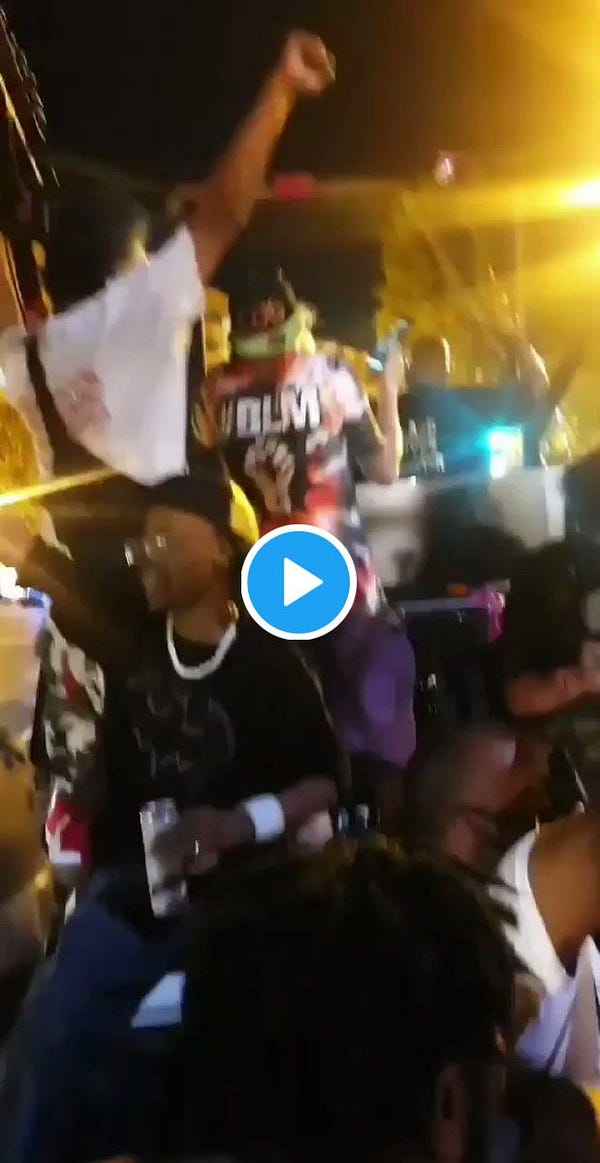
We cruised out of the chaos to the saxophone wails of Marvin Gaye’s “Mercy Mercy Me,” balmy night air blowing through our hair. As Gaye’s syrupy voice glistened over us, scenes of terror from the battlefield we’d just escaped started to slip away like a bad dream. I looked around at my fellow passengers and gleefully recognized people I’d befriended at the CHOP autonomous zone—as we hugged and exchanged protest stories, they told me they’d driven this music caravan up from Seattle, and had been harassed by police every stop of the way.
The caravan kept cruising through downtown DC to the sultry groove of Anderson Paak’s “Lockdown,” past protestors and tourists who waved and cheered like we were heroes. Meanwhile, the spotlight from a police helicopter tracking us from above bathed us in an eerie glow. As we turned the corner around a cluster of police cars, Dax’s “Black Lives Matter” started playing as if on cue, an angelic acapella filling the silence as protestors raised their fists and cops turned away.
I was too seduced by the music in this magical midnight joyride to realize until it was too late that the helicopter had been tracking us for a reason. Suddenly, cops on bikes surrounded us from every direction, and as I tried to jump off, one grabbed me by the shoulders and shouted “not so fast!” They cordoned off the caravan with police tape so no one could escape, and started questioning everyone, patting them down, recording our names and addresses, and eventually arresting the driver—all while refusing to tell us what we were being detained for.
Heart in my throat, visions of getting deported flashing through my head, I tried to remain calm while the officers asked me if I had witnessed any illegal activity on the caravan (nope)—I didn’t understand why we were being detained, when similar caravans were all over the city blasting ads for politicians. Refusing to give any answers, they asked to see my Twitter instead.
An hour later, after a large crowd of angry protestors had gathered around the caravan screaming for our release, the cops finally let us go. “Goddamn, I’m just a nurse looking for something to do after work because the bars are closed,” said a guy sitting next to me. “You can’t do anything fun anymore in this city.” The caravan pulled away, protestors flashing their middle fingers as they blasted YG’s “Fuck Donald Trump.”
In the wake of that weekend’s fiery protests, DC’s Mayor Bowser mirrored Trump’s RNC speech when she accused “outside agitators” of causing havoc, drawing a comparison to the thousands of peaceful protestors who participated in the daytime March on Washington. Police Chief Peter Newsham also noted that 70% of the people arrested came from outside DC. “They are not the same as our residents who proudly say ‘Black Lives Matter,’” Bowser said, calling for the prosecution of “these agitators [who are] distracting from what our nation needs.”
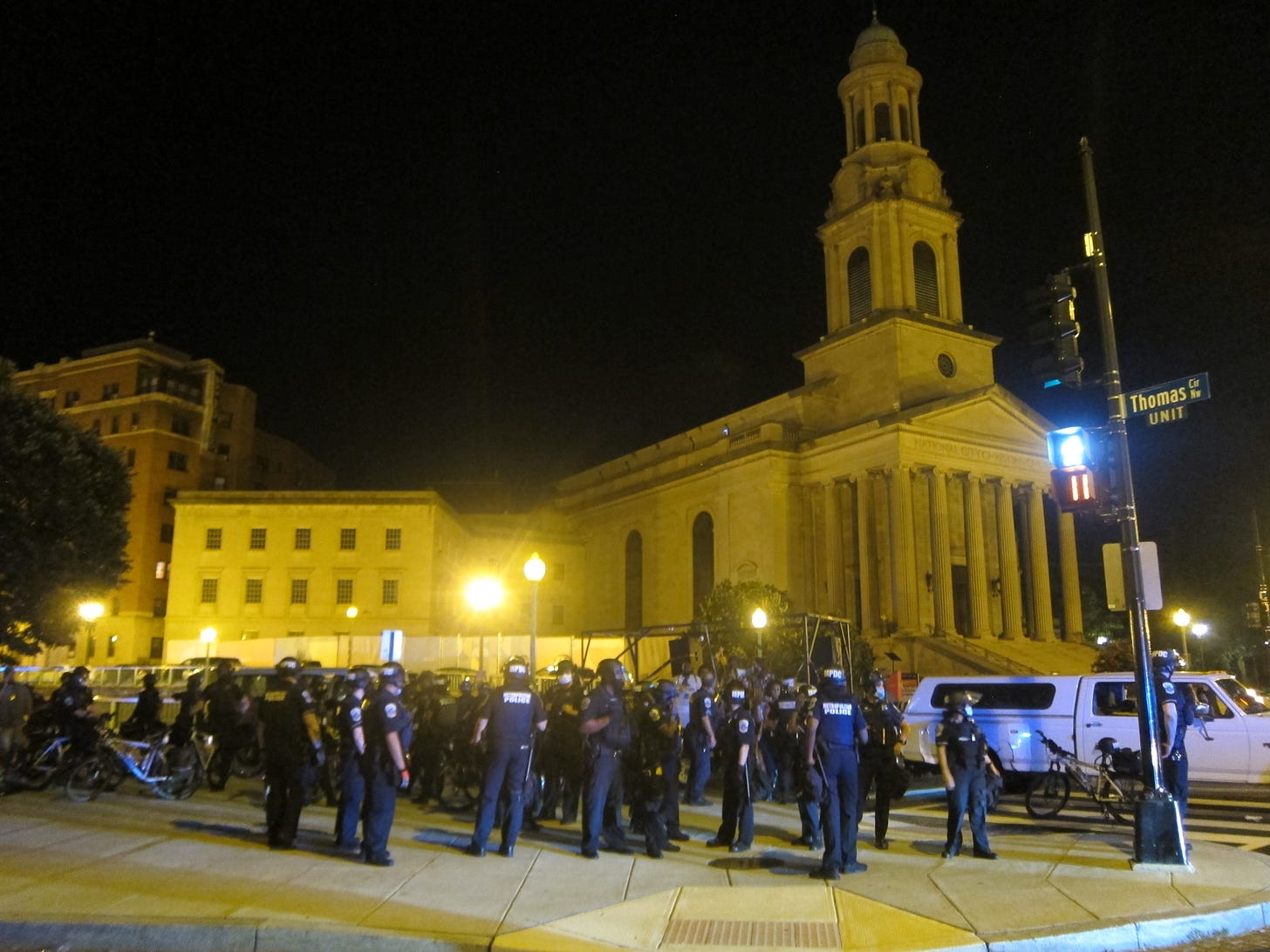
Police gathered around the CHOP music caravan
But this narrative didn’t fit what I’d experienced. Of course the majority of protestors came from out-of-state—these were the most passionate and die-hard activists from cities all over America, who decided to make a pilgrimage to DC despite the difficulty of traveling in a pandemic. (A local I met at the art gallery told me she doesn’t feel the need to protest every night, because DC sees a different theme of protests every year.) Most protestors that weekend showed up to both the daytime and nighttime marches—the main difference is that once darkness fell, the elders and families usually went home, leaving the younger generation on the streets.
I’m not sure what qualifies a protestor as an “agitator,” but I can say that the majority of protestors that weekend were extremely agitated, pissed off, and confrontational with police. Still, I never saw anyone throw anything more than a water bottle—while I did witness police attacking protestors with chemicals and rubber-coated metal bullets while shoving them to the ground. Further, the deescalatory stance that police took on the night of the Republic National Convention suggests that violent conflict is preventable—but cops have to take the lead.
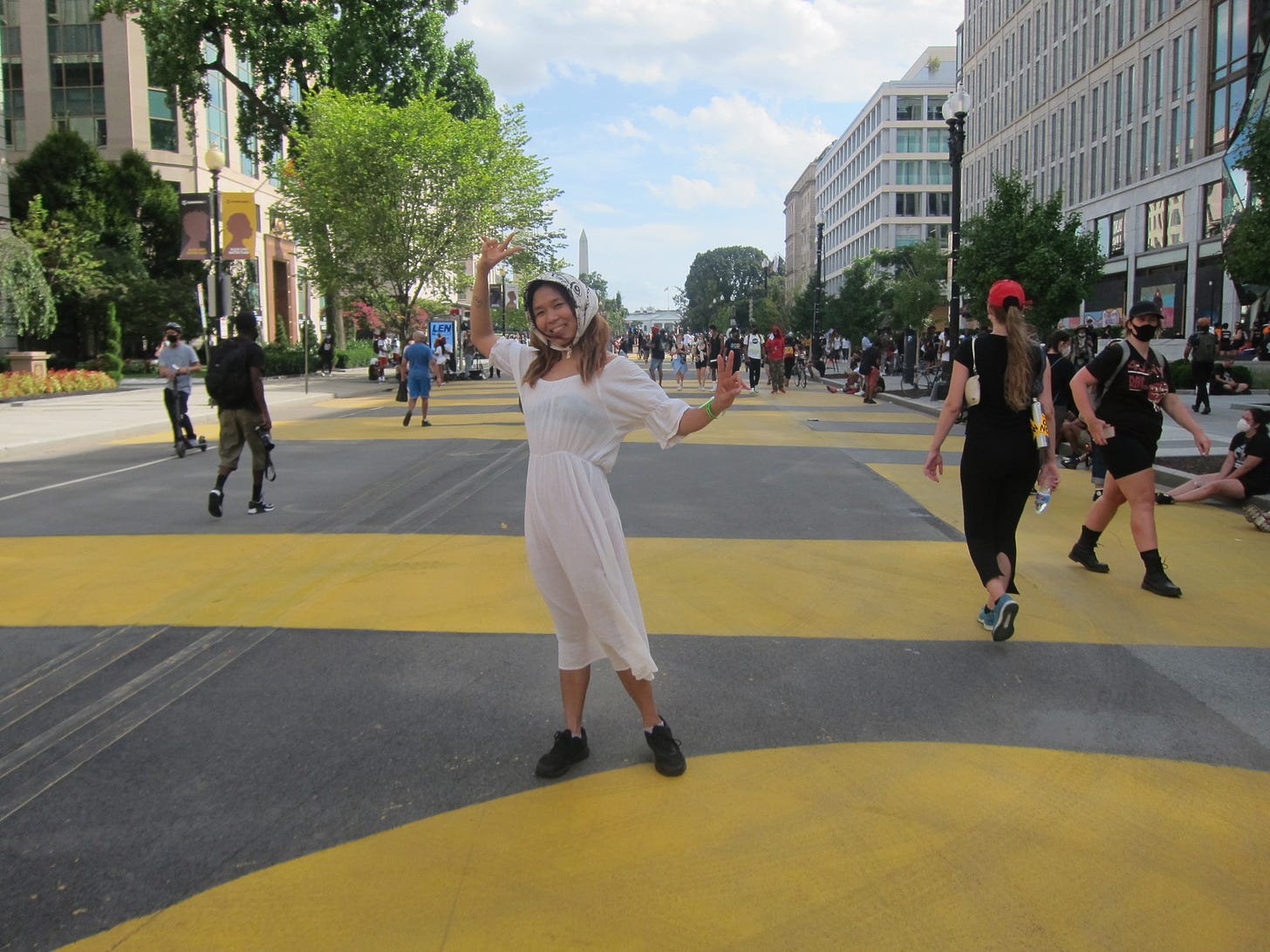
Yours truly at BLM Plaza
I headed back to the house I was sharing with a bunch of hippie kids I’d met at the airport. A model-influencer with a face etched in tattoos had left to join the protests in Kenosha, Wisconsin that morning, so I could take his bed. A white guy with dreads tossed me a bag of frozen peas to ice my ankle, while the house’s other inhabitants rolled a blunt and talked shit about a fellow housemate whose Tinder date that night turned out to be a Fed.
“Imagine fucking a pig!” I squealed, throwing the frozen peas on my throbbing ankle, then quickly passing out for a few hours of sweet deep sleep before it was time to move again.



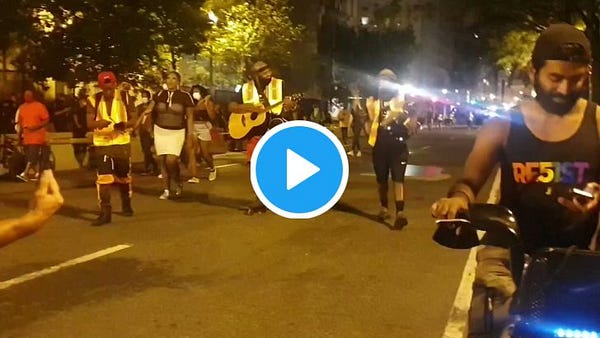
What a journey. It seems crazy to me that politicians in DC are annoyed about protestors coming in from out of town. DC is literally the seat of power for the entire country. What do they expect??
Thank you for sharing/risking/reporting Michelle <3
Appreciate you reaching out to share this with me. That was a wild night!